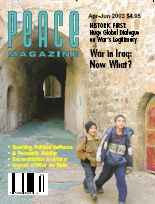
Peace Magazine Apr-Jun 2003, page 28. Some rights reserved.
Search for other articles by Maggie Helwig here
John Hagan, Harvard University Press
John Hagan’s expressed aim, in Northern Passage, is to show that coming to Canada was a rational decision and a positive turning-point in the lives of most draft resisters. This is actually not very difficult to demonstrate, nor is it a very unexpected conclusion, so the real value of the book lies in the tangential material.
The most significant chapter—though also perhaps the dryest—is “Opening the Gates,” where Hagan examines recently declassified Canadian government documents and traces the fluctuations of immigration policy both as it existed on paper and as it was practised at the border, leading up to the announcement of May 22, 1969, that Americans would be admitted to Canada entirely without regard to their military status. This chapter also has some interesting resonances for the present day, notably the interplay between the Canadian government’s fear of offending Richard Nixon, and the successful campaign by various groups (Hagan singles out the United Church) to reposition immigration policy as a Canadian sovereignty issue.
Other chapters are a mixture of relatively unsurprising statistical analysis and entertaining anecdotal material. The weakest section follows the campaign for amnesty after 1973; this leads Hagan away from his main subject, and we suddenly find ourselves spending a lot of time with a resister who went to England instead (this is not without a kind of significance of its own—those who came to Canada were often ambivalent or lukewarm about amnesty, at least as it pertained their own personal situation, many of them having found that Canada suited them rather well).
Scattered through the book are any number of curious and interesting facts—that “draft dodgers” and “deserters,” though quite different demographically on their arrival, with the “deserters” being less educated and from more disadvantaged backgrounds, have converged over their years in Canada and now have nearly identical incomes and employment patterns; that resisters who arrived in 1970 have, to this day, a stronger identification with the US than those who arrived earlier or later (something Hagan attributes to the War Measures Act and their consequent difficulty in forming a positive image of Canada); and that Pat Buchanan has been smacking Canada upside the head since at least 1973.
The last chapter, “Choosing Canada,” could probably have been a book on its own, engaging as it does with the always interesting question of self-definition while Hagan looks at the various ways in which those resisters still living in Canada speak and think about their mixed identities. They include a woman who, while not particularly interested in identifying any longer as “American,” still finds it important to be “from New York”—which reminds me of an emigrant from former-Yugoslavia I met once in The Hague, who wanted to be identified either as “European” or “Belgradian.” Cities have a meaning of their own, which cannot easily be captured in national terms.
This is a somewhat scattershot and miscellaneous book; this is in a way its strength, but also its weakness. I was a child during the Vietnam War, but I count many of the Americans who came to Canada among my friends and colleagues today, and so even from my somewhat removed perspective I can see too many things that Hagan has omitted. While he frequently speaks of the need to include women, in fact he often does not do so—in one important piece of analysis, where he looks at the resisters’ ongoing political involvement, he includes women in his sample only if they came as spouses of men at risk of the draft; though he admits that this skews his figures, since women are generally more politically active than men. Yet women who came alone, or as mothers of draft-age sons, formed a significant part of the Vietnam-era exodus (Judith Merrill and Jane Jacobs, to mention two of the most famous). Sometimes entire family groups emigrated together, even some families where no member was at immediate risk from the draft but who nevertheless saw the Vietnam War as a primary motive for leaving the United States. This is a phenomenon Hagan does not even acknowledge—a statistically small category perhaps, but socially important.
It is not Hagan’s aim to present a full picture of the war resisters who came to Canada, and so he cannot be faulted for failing to do so; but it seems to me that this is a rich area of political and cultural inquiry that is only beginning, far too late, to be seriously studied. (And there are an almost infinite number of angles from which to study it—I recently read an interesting article, intended mostly for rare book collectors, about variant editions of Anansi’s famous Manual for Draft Age Immigrants to Canada). The Vietnam War changed Canada in profound ways that could never have been predicted, by sending north across the border some of the best people that a generation had to offer, people who would shape Canadian politics and culture in wide-ranging ways. Hagan notes that he has freely used the term “draft dodger” as an equivalent to “draft resister” (though he prefers “military resister” to “deserter”), because “draft dodger” still has positive connotations in Canada. As well it should; and let’s hope that it always does.
Maggie Helwig is a Toronto-based writer and activist.

Peace Magazine Apr-Jun 2003, page 28. Some rights reserved.
Search for other articles by Maggie Helwig here